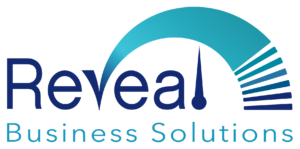KPIs Can Help You Navigate Economic Uncertainty
By: Maggie Regalia, CPA, Director of Business Development and Fractional CFO, Reveal Business Solutions
Economic indicators are currently sending out some conflicting messages, as the economy seems to be growing by one measure and shrinking by another. Business investments have declined recently, but the labor market is hot, and inflation continues to erode the spending power of many Americans. Even companies that are thriving feel like they’re waiting for the other shoe to drop. In the meantime, small and medium-sized businesses are left to grapple with a lot of uncertainty as we work our way through the lingering effects of the pandemic.
The big question for most business owners is whether or not there will be a recession. Based on history, we usually don’t know we’re in a recession until after it’s begun, at which point our options for responding are pretty limited.
The good news is that by monitoring some key performance indicators (KPIs), business owners can gain insight into how their companies are doing today and get a feel for how things are trending. Paying attention to your business data also makes it possible to respond quickly to any red flags, and generally allows you to be better positioned for an economic downturn should one occur.
KPIs to Watch and What They Tell You
There are many different types of KPIs, such as financial, operational, customer success, leading vs. lagging, etc. To look for signs of a possible recession, we’re going to focus on quantitative financial ratios. Analyzing these ratios offers insights into profitability, liquidity, operational efficiency, and solvency – all good things to stay on top of in a time of economic volatility.
KPI: Days Sales Outstanding (DSO)
How to calculate: (DSO) = (accounts receivable/total credit sales) x number of days
What it tells you: DSO measures the average number of days it takes your company to collect payment from your clients. If you see this KPI increasing over time it could be a sign that either 1) your collection procedures are ineffective, or 2) your customers are experiencing cash flow constraints.
Action: Higher DSO means less cash on hand for your business, which could lead to higher borrowing costs to finance operations or grow the business. The worst-case scenario is insolvency. If DSO is going up, it may be time to have a conversation with customers about how their business is going, reassess your accounts receivable management practices, or start requiring more substantial deposits.
KPI: Revenue Concentration
How to calculate: Revenue Concentration = (Revenue for Customer/Total Revenue) x100
What it tells you: Also referred to as Customer Concentration, this KPI shows what percent of revenue comes from a single customer. High revenue concentration can be a risk factor because it puts your business in jeopardy should that revenue source be negatively impacted by economic conditions.
Action: If you have a high revenue concentration, it may be time to diversify your offerings or search for another way to generate residual income, even if temporarily.
KPI: Gross Margin
How to calculate: Gross Margin = (Net Sales – Cost of Goods Sold)/Net Sales x 100
What it tells you: Gross Margin is the amount of money a company retains after accounting for the direct costs associated with producing the goods it sells and the services it provides. The higher the gross margin, the more money the company keeps. Gross Margin is critical to running any business.
Action: Higher costs due to inflation will decrease your gross margin, which means you have less money to pay for operating expenses or to grow the business. If inflation is eating into your Gross Margin, it’s best to react quickly by either finding alternative material sources or increasing prices.
KPI: Cash Gap a.k.a. Cash Conversion Cycle (CCC)
How to calculate: CCC = DSO + Days Inventory Outstanding – Days Payable Outstanding
What it tells you: CCC measures the time between when you pay expenses associated with the goods or services you provide and when you receive payment for those goods or services. Your Cash Gap or CCC is a financial shortfall that the company must fill using other sources of money, such as cash reserves or short-term borrowing. By combining three other essential KPIs (DSO, DIO, DPO), you can gauge how well your company is using its working capital. DSO measures the average number of days it takes your company to collect payment from your clients. Days Inventory Outstanding (DIO) measures the average number of days that a company holds inventory before turning it into sales. Days Payable Outstanding (DPO) is the average number of days it takes for your company to pay its bills.
Action: Supply chain disruptions may have forced you to increase your purchasing lead times at the same time your customers may be taking longer to pay. By knowing your cash gap ratio, you can determine whether you have enough reserves on hand to see you through. Potential actions may include:
- Expand the short-term line of credit with your bank
- Increase pricing to cover the cost of the cash gap
- Adjust how you manage relationships with customers and suppliers
Using Business Data for Better Insights
Financial ratios can provide crucial insight into your company’s liquidity and long-term solvency. By monitoring these KPIs, you’ll be better prepared to anticipate and adjust for a potential recession. If you have questions about how to track your KPIs, contact us at Reveal Business Solutions. We can help you make sense of your business data, so you have the insights you need to ride out economic uncertainty and keep growing your business.
